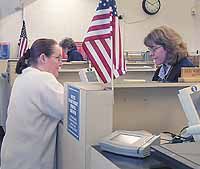| Shannon Draper assists Monica Safreed at the counter in the Price post office. Safreed and other post office patrons encountered a busier mailing facility than usual because of all the local residents who waited until the April 15 deadline to submit the income tax returns to the state and Internal Revenue Service. The latest data complied by the United States Census Bureau ranks Utah’s 2000 tax burden as a percent of personal income as the ninth highest in the nation. When fees are factored into the equation, Utah’s total burden ranked 10th in the United States. |
The tax burden shouldered by Utahns continues to climb.
The latest data indicate Utah’s state and local tax burden as a percent of personal income registered ninth highest in the nation.
When fees are factored into the equation, Utah’s total burden ranked 10th in the United States in 2000.
The Utah Taxpayers Association annually calculates the burdens for all 50 states based on the U.S. Census Bureau’s annual finance report.
Utah’s total tax and fee burden increased rose from 15.2 percent to 15.3 percent, exceeding the national average by 2.5 percent.
Alaska has the highest tax burden at 16.7 percent, followed by New York, New Mexico and Wyoming.
However, residents in Alaska and Wyoming pay no state income taxes. The two states are also able to “export” taxes due to taxes imposed on natural resources like oil, natural gas and coal, pointed out the association.
Excluding fees, Utah’s tax burden climbed to 11.6 percent of personal income in 2000 and exceeded the national average by 7 percent.
Utah’s motor fuel taxes ranked seventh and registered 71 percent higher than the national average.
Utahns spent 0.65 percent of personal income on motor fuel taxes, compared to the 0.38 percent national average.
High motor fuel tax burdens are common in mid-western, southern and Rocky Mountain states with high growth rates, noted the association.
Montana maintained the highest burden at 0.94 percent of personal income, followed by Mississippi, North Dakota, Idaho, Arkansas, South Dakota, Utah, West Virginia, Wisconsin and Wyoming.
Utah’s general sales tax burden dropped from eighth to ninth place in 2000. But at 3.62 percent of personal income, the state’s general sales tax burden remained significantly higher than the national average of 2.66 percent.
Washington reported the highest general sales tax burden at 4.89 percent. However, Washington collects no state income tax.
Utah’s individual income tax burden jumped from 16th to 13th place and registered 24 percent higher than the U.S. average.
Utah’s individual income tax burden consumes 3.25 percent of total personal income, a significant 14 percent increase from 2.86 percent in 1993, pointed out the association.
At 4.49 percent, New York posted the highest individual income tax burden.
Utah’s 2000 property taxes ranked 35th and registered 16.9 percent below the national average. Utah’s property tax burden increased 3.3 percent from the prior year and represented 2.57 percent of personal income.
When encountering budget shortfalls or program cutbacks, proponents of continued government funding frequently call for property tax hikes, citing Utah’s comparatively low burden as justification, explained the association.
But if property taxes were increased to the national average and all other assessments remained unchanged, Utah’s total tax and fee burden would jump to fourth place in the U.S. comparisons.
Tax burdens can be measured in several ways – as a percent of personal income, as a percent of gross state product, per capita or per worker, noted the association.
Favored by the majority of economists, calculating the burdens as a percent of personal income or gross state product is the most applicable measure of government’s share of the state’s economy.
Per capita or per worker measurements can lead to misleading conclusions, especially in Utah’s case, explained the association.
Per capita measurements do not account for wage differences.
For example, a $3,500 per capita tax burden exerts a greater impact in a low wage state.
The measurements include non-wage earning youth, particularly children younger than age 16.
Per worker measurements do not account for variations in labor forces.
Compared to the rest of the nation, Utah’s workforce contains a higher percent of part-time teenage wage earners.
Utah has more teenagers per capita than any state. And 62 percent of Utah’s teenagers are employed compared to 52 percent nationwide, concluded the association.

